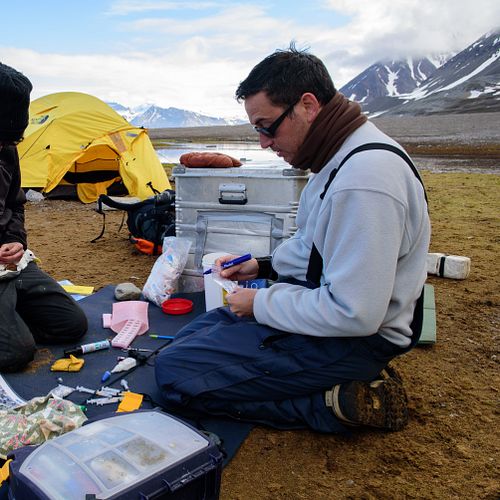21. februar 2020 nyhet
Potential consequences of exposure to legacy persistent organic pollutants on incubation behaviour in Svalbard kittiwakes
Egg incubation is an important and energy-demanding stage during the avian reproductive cycle. It involves different parental care behaviour such as egg-turning and egg-warming, both considered as key determinants for hatching. Egg-turning behaviour requires an optimal turning rate with an appropriate angular change facilitating the absorption of albumen by the embryo, reducing the malposition of the embryo inside the egg, and preventing the embryo from adhering to the inner shell membrane. On the other hand, maintaining the egg at an optimal temperature is critically important for the complete embryonic development. In birds, parental behaviour is strongly influenced by hormonal regulation. A rise in the secretion of the “parental” hormone prolactin during egg-laying plays a central role in the initiation and maintenance of incubation behaviour. Concomitantly, the pectoral skin of incubating birds becomes a fleshy and well-vascularized brood patch, devoid of feathers, allowing direct contact with the egg to ensure proper heat transfer between a parent and the developing embryo in the egg.
Through their endocrine disrupting properties, a wide range of environmental contaminants can possibly modulate parental care behaviour in wild birds. Among them are the persistent organic pollutants(POPs), a group of chemicals synthetically manufactured and extensively used during the 20th century in numerous industrial, commercial and agricultural applications. Harmful for living organisms, POPs have been the focus of toxicological studies leading to past and on-going national and international regulations, well-illustrated by the Stockholm Convention to protect human health and environment.Despite overall temporal declining trends, the so-called “legacy POPs”, a group of organic contaminants prohibited for decades, are still present in high concentrations and highly toxic for wildlife. Due to their high volatility and strong persistence, POPs reach remote areas such as the Arctic. Once deposited in the marine ecosystem, they are assimilated by living organisms through food intake. Long-lived species, like many polar seabirds that occupy high trophic levels, are exposed to a greater risk of accumulation and sensitivity to high concentrations of POPs.
This is the case in the Norwegian Arctic where black-legged kittiwakes (Rissa tridactyla) are chronically exposed to a complex mixture of pollutants which have already been linked to the disruption of reproductive hormones and impaired reproductive performance. Using artificial eggs equipped with miniaturised data-loggers, we investigated whether the most contaminated parent birds are less able to warm and turn their egg, and thus less committed to incubating their clutch. Recently developed, these egg-loggers provide precise and continuous recording of incubation temperature and egg-turning behaviour, providing new opportunities to investigate the fine scale consequences of exposure to environmental pollutants on the reproductive behaviour in wild birds.
Our results revealed that blood concentrations of oxychlordane, the main metabolite of chlordane, a banned pesticide already known as being very toxic for Arctic seabirds, were negatively related to incubation temperature in male kittiwakes. In addition, we reported a significant and negative association between blood oxychlordane concentrations and both the size of the brood patch and the metabolic activity, providing potential underlying mechanisms. In this context, a reduction in the size of the brood patch and lower energy expenditure in the most oxychlordane-contaminated birds logically decreases the amount of heat transferred to their eggs. Such effects of oxychlordane on incubation temperature could induce deleterious consequences for egg hatchability.
Our results also revealed that blood concentrations of polychlorinated biphenyls (PCBs), the most abundant toxic POPs in Arctic kittiwakes, were negatively related to egg-turning in female kittiwakes. We found that most PCB-contaminated birds turned their eggs with the lowest angular amplitude. Such impairments may be explained by a disruption of prolactin secretion in the most exposed PCB kittiwakes. Interestingly, in glaucous gulls (Larus hyperboreus), another Arctic seabird, exposure to PCBs was also found to be associated with both reduced nest attendance and prolactin secretion.
Although banned for several decades, our results pointed-out some subtle effects of legacy POPs on incubation behaviour in Arctic kittiwakes (i.e. egg-turning and incubation temperature). In turn, such variations of egg-tuning behaviour and/ or incubation temperature may impact the reproductive success of kittiwakes. Our study is purely correlative, it was not possible to establish causality and cautious interpretation is warranted. Further studies with a similar fine scale approach in controlled conditions should be conducted in the future and would enable a better understanding of the way environmental contaminants are impacting bird reproduction.
This study has been realised during the PhD thesis of Pierre Blévin (2015-2018; CEBC-CNRS, France), under the supervision of Olivier Chastel (CEBC-CNRS, France) and Paco Bustamante (LIENSs – University of La Rochelle, France); and completed at Akvaplan-niva AS (2019-2020). The project was funded by the French Polar Institute (project 330 to Olivier Chastel), the ANR ILETOP (ANR-16-CE34-0005), and the Contrat Plan-Etat Région (ECONAT). Pierre Blévin was funded by a PhD grant from the University of La Rochelle. Additional funding was provided by the Fram Centre (Multiple Stressor seabird project from Hazardous Substances Flagship).
References:
Blévin, P., Shaffer, S., Bustamante, P., Angelier, F., Picard, B., Herzke, D., Moe, B., Gabrielsen, G.W., Bustnes, J.O., Chastel, O., 2020 Contaminants, prolactin and parental care in an Arctic seabird: Contrasted associations of perfluoroalkyl substances and organochlorine compounds with egg-turning behaviour. General and Comparative Endocrinology 291, 113420.
Blévin, P., Shaffer, S., Bustamante, P., Angelier, F., Picard, B., Herzke, D., Moe, B., Gabrielsen, G.W., Bustnes, J.O., Chastel, O., 2018. Organochlorines, perfluoroalkyl substances, mercury and egg incubation temperature in an Arctic seabird: insight from data loggers. Environmental Toxicology and Chemistry 9999, 1–14.





